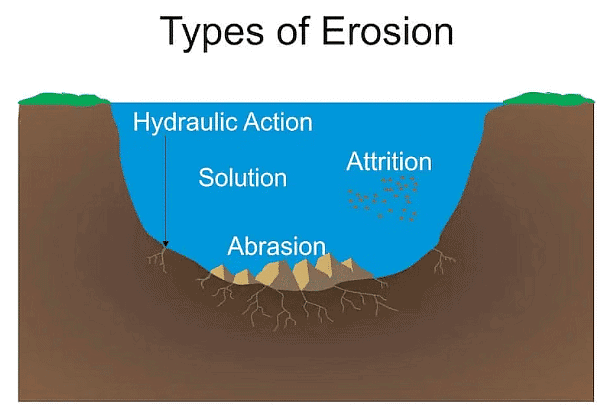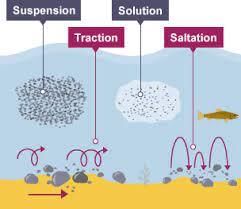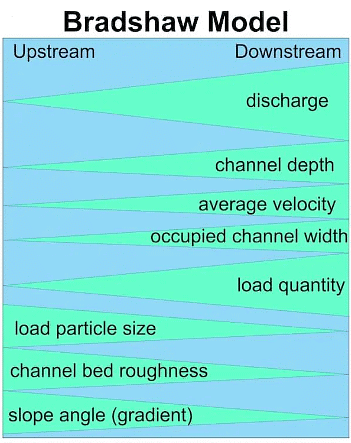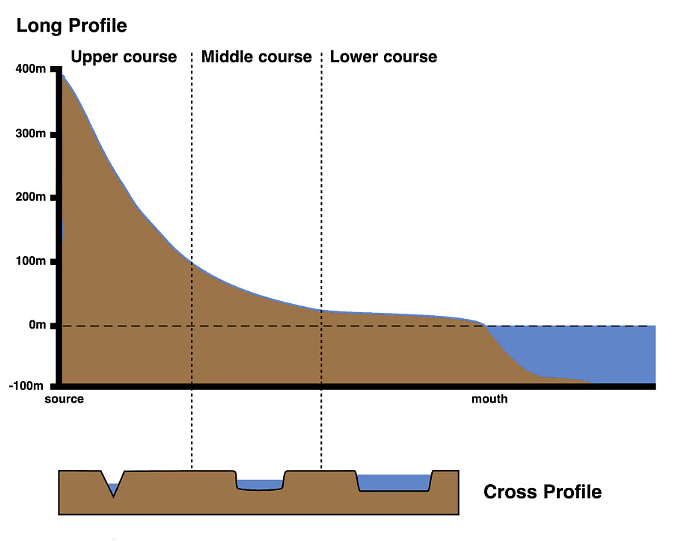Class 10 Exam > Class 10 Notes > Geography for GCSE/IGCSE > River Processes
River Processes | Geography for GCSE/IGCSE - Class 10 PDF Download
| Table of contents |

|
| River Processes |

|
| Deposition in River Systems |

|
| River characteristics |

|
| River Course Characteristics |

|
River Processes
- Erosion is the process of wearing down surfaces over time.
- River channels are shaped by four main erosion processes:
- Hydraulic action: This is the force of the water against the riverbanks and bed, dislodging and eroding material through sheer pressure.
- Abrasion: This is the process where rocks and stones carried by the river wear down the riverbed and banks as they are dragged along.
- Attrition: In this process, rocks and stones carried by the river collide and break into smaller pieces, becoming smoother over time.
- Corrosion (solution): This is the process where certain minerals in rocks are dissolved by the water, leading to erosion.

Erosion can be categorized as mainly vertical or lateral:
- Vertical erosion: This is predominant in the upper course of rivers where the river erodes downwards, deepening the river and valley over time.
- Lateral erosion: This type is more common in the middle and lower courses of rivers, causing the river and valley to widen as it erodes sideways.
Transportation in Rivers
Types of Transportation: There are four primary processes of transportation in rivers:
- Traction: This process involves the rolling of large particles along the riverbed.
- Saltation: Here, smaller particles are bounced along the riverbed in a leapfrogging motion.
- Suspension: Fine particles are carried within the flow of the river without settling to the riverbed.
- Solution: Dissolved materials are transported within the body of the river.

Deposition in River Systems
- When a river lacks the energy to transport materials, it deposits them. This process is known as deposition.
- The primary reasons for reduced energy in rivers leading to deposition include:
- Decreased discharge caused by factors like low precipitation or water abstraction upstream.
- Reduced gradient along the river's course.
- Slower flow, particularly on the inner side of river bends or where the river is shallower.
- When the river reaches a sea, ocean, or lake.
- Heavier materials are typically deposited first, constituting the bedload.
- Lighter materials such as gravel, sand, and silt, termed as alluvium, are carried further downstream.
- Dissolved materials are transported out to the sea.
Changes in River Characteristics
- As a river undergoes erosion, transportation, and deposition, its characteristics evolve as it progresses downstream.
- These alterations are succinctly described in the Bradshaw model.

Question for River ProcessesTry yourself: Which process of erosion is responsible for the dislodging and eroding of material through sheer pressure?View Solution
River characteristics
- Every river possesses longitudinal and transverse profiles.
- While each river's profiles are distinct, they share some common traits.
- These profiles depict alterations in river attributes as they progress from their origin to the outlet.
Long Profile
- The long profile of a river illustrates the variations in gradient from its origin to its terminus.
- Typically, long profiles exhibit a concave shape and share several common features:
- The source commonly originates in elevated regions.
- The upper reaches of the river often encompass steep terrain with irregular surfaces.
- As the river progresses into its middle course, the gradient tends to diminish.
- In the lower section, the gradient further reduces, eventually reaching near-flat levels.

Cross profiles
- River cross profiles are representations of cross-sections from one riverbank to the other.
- Cross profiles across the upper, middle, and lower courses depict alterations in the river channel.
- Upper course attributes consist of:
- Shallow depth
- Steep valley sides
- Narrow width
- Low velocity
- High bedload
- Irregular channel bed
- Elevated friction levels
- Vertical erosion
River Course Characteristics
Middle Course Characteristics:- Deeper than upper course channel
- Gentle valley sides
- Wider than upper course channel
- Greater velocity than upper course channel
- Material in river decreases in size
- Smoother channel bed
- Lower levels of friction than upper course channel
- Lateral erosion
Lower Course Characteristics:
- Deeper than middle course channel
- Flat floodplains
- Wider than middle course channel
- Greater velocity than the middle course channel (except as the river nears the mouth)
- Material carried mainly sediment and alluvium
- Smooth channel bed
- Lowest friction
- Deposition is dominant
The document River Processes | Geography for GCSE/IGCSE - Class 10 is a part of the Class 10 Course Geography for GCSE/IGCSE.
All you need of Class 10 at this link: Class 10
|
55 videos|68 docs|78 tests
|
FAQs on River Processes - Geography for GCSE/IGCSE - Class 10
| 1. What are the main processes that shape river systems? |  |
Ans. The main processes that shape river systems are erosion, transportation, and deposition. Erosion is the wearing away of the land by the force of the river. Transportation is the movement of eroded materials by the river, and deposition is the laying down of these materials along the river's course.
| 2. How does deposition occur in river systems? |  |
Ans. Deposition in river systems occurs when the river's velocity decreases, causing it to drop the sediment it was carrying. This can happen when the river enters a larger body of water, when the gradient of the river decreases, or when there is a change in the river's channel.
| 3. What are some characteristics of rivers that impact their course? |  |
Ans. Some characteristics of rivers that impact their course include the gradient (slope) of the river, the amount of water flowing through it (discharge), the shape of the river's channel, and the type of sediment it is carrying.
| 4. How do river course characteristics influence river processes? |  |
Ans. River course characteristics, such as the gradient and shape of the channel, can impact how quickly the river flows and how much sediment it can carry. For example, a steeper gradient will result in faster flow and more erosion, while a wider channel can slow down the river and lead to deposition.
| 5. What role do human activities play in altering river processes? |  |
Ans. Human activities, such as dam construction, deforestation, and urban development, can significantly alter river processes. Dams can regulate the flow of water, impacting erosion and deposition, while deforestation can increase sediment runoff into rivers, affecting their course. Urban development can lead to channelization and straightening of rivers, changing their natural processes.
Related Searches




















